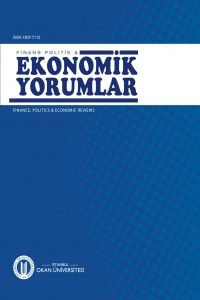Reel Faiz Paritesi Koşulunun Doğrusal ve Doğrusal Olmayan Modellerle Sınanması: G7 Ülkeleri Analizi
1970’li yıllardan bu yana dünya finans piyasalarındaki gözle görülür değişikliklerden birisi de, finansal sermaye hareketlerindeki kısıtlamaların kaldırılmasına paralel olarak ülkeler arasındaki bütünleşme derecesindeki ve sermaye akımlarının miktarındaki artıştır. Uluslararası piyasaların bütünleşme derecesi ise ampirik olarak, uluslararası finansın köşe taşlarından birisi konumunda olan ve Güvencesiz Faiz Paritesi ile Satın Alma Gücü Paritesi’ni kapsayan Reel Faiz Paritesi Hipotezi (RIP) vasıtasıyla ölçülebilir. Dolayısıyla, RIP’den sapmalar piyasaların bütünleşme derecesinin bir göstergesidir. Bu çalışmada ise, 1974:Q1-2008:Q4 dönemine ait üçer aylık verilerle gelişmiş G7 ülkelerinde kısa ve uzun vadeli faizlerden hareketle RIP’ın geçerliliğinin birim kök testleriyle sınanması amaçlanmaktadır. Bunun için analizlerde, geleneksel ve yapısal değişime olanak veren birim kök testlerinin yanında doğrusal olmayan birim kök testleride kullanılmıştır. RIP’nin geçerliliğini yapısal değişime olanak tanıyan doğrusal ve doğrusal olmayan birim kök testleri çerçevesinde ele almak çalışmanın önemli bir yönünü oluşturacaktır. Analiz sonuçları G7 ülkelerinde piyasa entegrasyonu olduğu yönündedir.
Anahtar Kelimeler:
Reel faiz oranı paritesi, yapısal kırılma, doğrusal ve doğrusal olmayan birim kök sınamaları, TAR, ESTAR
Testing Real Interest Parity with Linear and Nonlinear Models: The Case of G7 Countries
One of the most striking developments in the world financial markets since the 1970s has been the increasing degree of integration as constraint to the movement of financial capital have been gradually relaxed. In this process, the total amount of the capital has flown among the developed and developing countries significantly increased over the years. The extent of market integration can be empirically observed and measured using the international parity conditions. The real interest parity (RIP) condition combines two cornerstones in international finance, uncovered interest parity (UIP) and ex-ante purchasing power parity (PPP). The extent of deviation from RIP is therefore an indicator of the lack of product and financial market integration. This paper investigates whether real interest parity (RIP) among G7 countries hold or not over the period 1974:Q1–2008:Q4 using both short and long run definitions of interest rates. This is done by carrying out a set of unit root tests, not also traditional unit root tests with structural breaks but also non-linear unit root tests on the real interest differentials with respect to USA. We consider whether or not adjustments towards RIP are nonlinear. Our empirical results reveal a high degree of market integration for G7 countries and indicate that there is evidence in favor of RIP
Keywords:
Real interest rate parity, structural break, linear and nonlinear unit root tests, TAR, ESTAR,
- ISSN: 1307-7112
- Başlangıç: 1963
- Yayıncı: İstanbul Okan Üniversitesi
Sayıdaki Diğer Makaleler
Kurumsal Yönetim Uygulamaları ve Firma Değeri İlişkisinin Araştırılması: İMKB Üzerine Bir Uygulama
Halil Cenk SÜER, Sinem Derindere KÖSEOĞLU
Türkiye Ekonomisinde Cari Açık Sorunu ve Nedenleri
Cüneyt Yenal KESBİÇ, Esat BAKIMLI
Finansal Piyasaların Niteliği ve Kriz Üretme Potansiyeli
Dış Ticaret Fiyat Değişimlerinin Sektörel Kaynakları
Reel Faiz Paritesi Koşulunun Doğrusal ve Doğrusal Olmayan Modellerle Sınanması: G7 Ülkeleri Analizi
